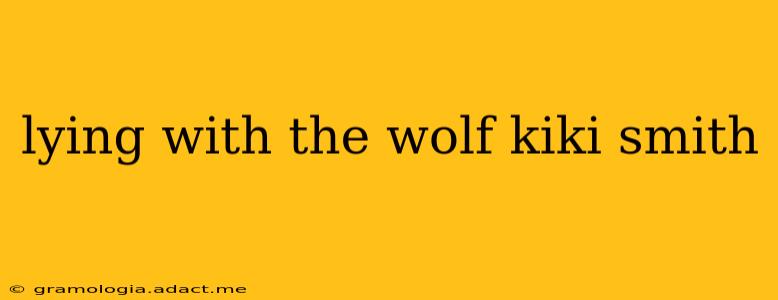Kiki Smith's "Lying with the Wolf" is more than just a striking print; it's a powerful exploration of myth, vulnerability, and the complex relationship between humans and the natural world. This evocative image, featuring a nude woman intertwined with a wolf, invites a multifaceted interpretation, prompting viewers to consider themes of fear, intimacy, and the untamed aspects of both human and animal nature. This post will delve into the artwork's symbolism, its creation, and its lasting impact on the art world.
What is the meaning of Kiki Smith's "Lying with the Wolf"?
The meaning of "Lying with the Wolf" is open to individual interpretation, but several key themes emerge consistently. The most prominent is the juxtaposition of vulnerability and strength. The nude woman, seemingly defenseless, is nonetheless intimately connected with the wolf, a creature often associated with danger and wildness. This suggests a complex interplay of fear and acceptance, a recognition of the wild within ourselves, and the potential for both harm and connection within seemingly opposing forces. The image challenges traditional notions of female vulnerability, presenting a figure both exposed and empowered by her proximity to nature's untamed power.
What materials did Kiki Smith use for "Lying with the Wolf"?
Kiki Smith's artistic process is often characterized by her use of diverse media and her willingness to experiment with texture and form. While the specific materials used in each iteration of "Lying with the Wolf" might vary (as prints often exist in multiple editions), her work frequently utilizes printmaking techniques such as etching, lithography, or screen printing. She masterfully integrates these processes to achieve a textured, often tactile quality, adding to the overall impact of the image. The prints often showcase her ability to blend linework with areas of tone and shadow, creating depth and enhancing the narrative.
How does Kiki Smith's work relate to the natural world?
Nature is a recurring and central motif in Kiki Smith's body of work. She frequently uses natural forms – human and animal bodies, plants, and the landscape – as metaphors to explore themes of mortality, spirituality, and the interconnectedness of all living things. "Lying with the Wolf" is a prime example of this preoccupation, showcasing a direct and intimate relationship between a human and an animal within a natural context. The animal is not presented as simply a dangerous predator, but as a powerful symbol of untamed life, mirroring and highlighting the raw energy within the human figure.
Is Kiki Smith's "Lying with the Wolf" a feminist artwork?
The feminist interpretations of "Lying with the Wolf" are significant. The image directly challenges traditional representations of women, moving away from idealized or objectified portrayals. Instead, Smith presents a woman who is both exposed and powerful, existing in a state of intimacy with nature, free from societal constraints. The artwork empowers the female figure by positioning her as an active participant in a primal scene, neither victim nor predator, but an equal participant in the wild. This portrayal reframes the narrative of female vulnerability, suggesting a strength found in embracing nature and its untamed forces.
Where can I see Kiki Smith's "Lying with the Wolf"?
Unfortunately, pinpointing the exact location of specific prints is difficult, as many are held in private collections. The best approach is to check the online databases of major museums and galleries known for their holdings of contemporary art. Many university art departments and specialized art historical databases may also list works in their archives. Furthermore, keeping an eye on upcoming exhibitions might reveal opportunities to view the artwork in person. Consulting art market databases and specialized art publications could also yield information on the current location of specific prints.
Conclusion:
Kiki Smith's "Lying with the Wolf" is a testament to her profound artistic vision and her ability to create works that resonate deeply with viewers. The artwork continues to spark dialogue and invites us to explore the intricate connections between the human and natural worlds, challenging preconceived notions and celebrating the raw power and vulnerability within us all. Its enduring impact on the art world speaks to its power to engage us long after we've encountered it.
